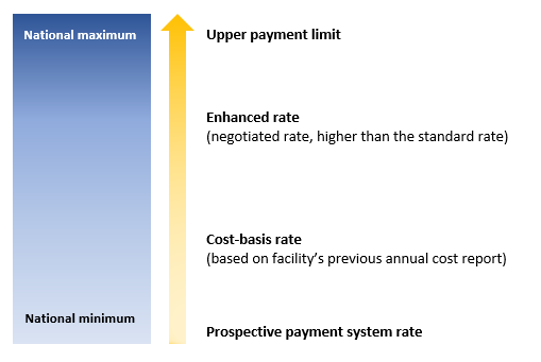
Comparing Reimbursement Rates

The different reimbursement rates available to your LTSS program can be highly complex. The information in the sections below highlights eight different types of rates that may be available to your program, as well as guidance on comparing those rates.
Some tribes choose to research this information and then decide what is the best fit. Other tribes find it helpful to work with an experienced accountant or financial expert to help determine which rate is the most beneficial.
Types of Reimbursement Rates
The information below is intended to provide you with a basic understanding of the issue so that you can move forward with choosing the right approach to ensure a strong funding strategy for your program.
Medical Assistance Rate
The Medical Assistance (MA) rate is a state's standard reimbursement for Medicaid-covered services. Each state sets how it will reimburse Medicaid recipients. For example, some states reimburse for each service provided during an encounter (a face-to-face interaction between the patient and the healthcare provider), rather than setting a flat fee for each encounter.
- Tribes can negotiate with their states for an enhanced or higher reimbursement rate for Medicaid-covered services based on a 100% Federal Medical Assistance Percentage or any other known factors about a particular state that may affect the negotiation.
Capitated Rate

A capitated rate is a contracted rate based on the total number of eligible people in a service area. Funding is supplied in advance, creating a pool of funds from which to provide services.
- This rate can be more beneficial for providers with a larger client base because unused funds can be kept for future use
- This rate can be challenging when serving high-expense or catastrophic cases since these types of unexpected expenses may mean all the funding gets used much earlier than intended
The Program of All-Inclusive Care for the Elderly (PACE) is an example of a fully capitated program.
Critical Access Hospital Rate
- LTSS delivered through a CAH facility may qualify for different reimbursement rates
- Reimbursement is on a per-cost basis instead of the standard Medicare reimbursement rates
Federally Qualified Health Center Rate
- Allowable expenses vary by state
- Each tribe and state must negotiate the exact reimbursement rate
- Tribes may be able to include waiver-covered LTSS in annual cost reports, even though not all LTSS qualify as encounters. This is an important clarification, since FQHC rates are based on your cost report from the previous year.
Fee-for-Service Rate
The fee-for-service rate reimburses providers for specific services, like office visits or tests. For example, if you visit your family doctor because you have a fever, and your doctor notices other symptoms and tests you for strep throat, the office visit and the test may count as two separate services. Insurers usually decide what types of things qualify as different services.
It is different than an all-inclusive rate, such as the IHS and FQHC rates, where billing is per encounter.
Indian Health Service Rate
The Indian Health Service (IHS) rate is an all-inclusive rate reimbursed to IHS and tribal facilities by CMS for Medicaid-covered services. Billing is per encounter, not per specific service.
- The IHS rate is mandated by the Department of Health and Human Services and is published yearly in the Federal Register. See the 2021 rate information.
- Allowable services vary by state
Managed Care Organization Rate
- Funding is based on a capitated reimbursement rate, which depends on how many people are enrolled in the system
- LTSS' use of managed care rates is increasing due to opportunities defined in the Affordable Care Act
Medicaid Waiver Rates
Medicaid waivers are channels through which states can deliver or pay for healthcare services through Medicaid. Waivers commonly support home- and community-based services. For example, 1915(c) home- and community-based waivers allow long-term care services to be provided through HCBS programs. Tribal members who qualify medically, financially, or geographically can receive services.
- Waivers offer coverage for services for people meeting certain qualifications
- Services covered by waivers may be funded at a different rate than a state's standard MA rate
Range of Reimbursement Rates
The amount of money Medicaid reimburses depends on individual state policies and other factors. However, reimbursement rates must fall between the federally established minimum and maximum payment limits.
This image shows where some reimbursement rates fall on this scale. Other rates, such as the Medicaid waiver rate or the FQHC rate, vary by state and may fall in different places along this scale depending on a particular state's policies and other factors.

Example: Comparing Rates
The comparison below shows one example of the important differences between two possible reimbursement rates: the IHS rate and the FQHC rate. All reimbursement rates have considerations like these that could have a big impact for your program. Be sure to investigate each one carefully before making a decision on which rate to use.
IHS Rate vs. FQHC Rate
Even though the IHS rate and the FQHC rate are both all-inclusive* rates, they cover different services at different rates.
IHS Rate
- Pharmacy visits count as a reimbursable encounter under the IHS rate
FQHC Rate
- Pharmacy visits are usually reimbursed at specific rate that is lower than the encounter rate
- Services to non-AI/AN patients can be reimbursed under the FQHC rate
- Your program's pharmacy use patterns could influence whether the FQHC rate or the IHS rate will provide a higher reimbursement level.
- Your facility's non-AI/AN patient population could influence which rate is more profitable.
* All-inclusive rates are billed by encounter, which means the calculation of a rate accounts for all of the allowable costs of providing care. This is the opposite of fee-for-service rates, where specific services are billed at specific rates, even if more than one service is provided during an encounter.
